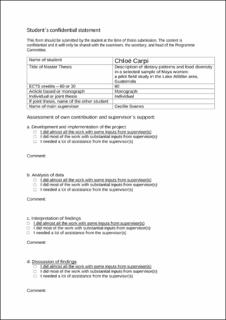| dc.description.abstract | Background Indigenous communities in Guatemala predominantly live in rural and difficult-to-reach areas. These communities have been historically discriminated, leading to a deficient social and political representation, and to poor understanding of the determinants of their health. A cross-sectional pilot study performed in 2021 among communities of indigenous Maya weavers living around the Lake Atitlán, Guatemala, collected anthropometric data that showed very high prevalence of short stature and overweight/obesity in women aged 14-77 years. Among the factors that may influence the anthropometric status of this population, diet composition and food diversity represent the most important, however, knowledge on these factors in indigenous communities is scarce. Aim The present study aims to describe the dietary patterns and diversity of a selected sample of Maya women who previously participated in the Lake Atitlán Respiratory Health Pilot Study, using the Minimum Dietary Diversity for Women (MDD-W), a standardized tool developed by the Food and Agriculture Organization of the United Nations (FAO). Methods The list-based MDD-W tool method was applied to develop a locally adapted tool assisted with pictures. This locally adapted MDD-W tool was then used in a two-weeks fieldwork during the dry season, to collect data for a pilot study of the dietary patterns and food diversity of a selected sample of Maya women living in the village of San Pablo la Laguna, close by the Lake Atitlán, Guatemala. The pilot study also collected socio-economic data and anthropometric measurements. One-hundred-and-forty-seven women who previously participated in the Lake Atitlán Respiratory Health Pilot Study, aged between 18 to 49 years and responsible for the nutrition in their household, were attempted to be invited using a community-led approach. Results A total of 86 participants were included in this study. Anthropometric measurements revealed that 78% of the women had an excess of weight and 84% had a waist-for-height ratio over the threshold of 0.5, known to be related to increased risk of cardio-metabolic and other diseases. Participants had a plant-based diet: 97% of the participants reported consuming grains, 90% pulses, 88% vegetables, 79% fruits and 78% dark green leafy vegetables, all during the last 24 hours. Regarding the animal-proteins intake, eggs were consumed by 94% of the participants, fish by 53%, poultry by 30%, and red meat by only 20%. The consumption of sugar-sweetened beverages was common: sweetened coffee was consumed by 85% of the participants and other sweetened beverages by 50%. Among the ten healthy food groups defined by the tool, the participants consumed on average 7.6 different groups, and close to 92% of them achieved the minimum dietary diversity as defined by the tool. Conclusion This pilot study using the list-based MDD-W tool method, locally adapted and assisted with pictures, enabled to describe the diet composition on a group level, showing a dietary pattern with mainly plant-based foods including grains, pulses, fruits and vegetables with small quantities of animal proteins except for eggs and fish. Thus, the local adaptation of the tool seemed to fit the participants’ diet during the investigated dry season in terms of dietary pattern. However, the group diversity score that was calculated from the values of the MDD-W tool indicated a surprisingly high dietary diversity, which appeared to be overestimated for this population. Further studies are recommended to also assess foods quantities in order to describe and understand the dietary habits of Maya women living by the Lake Atitlán. | |

